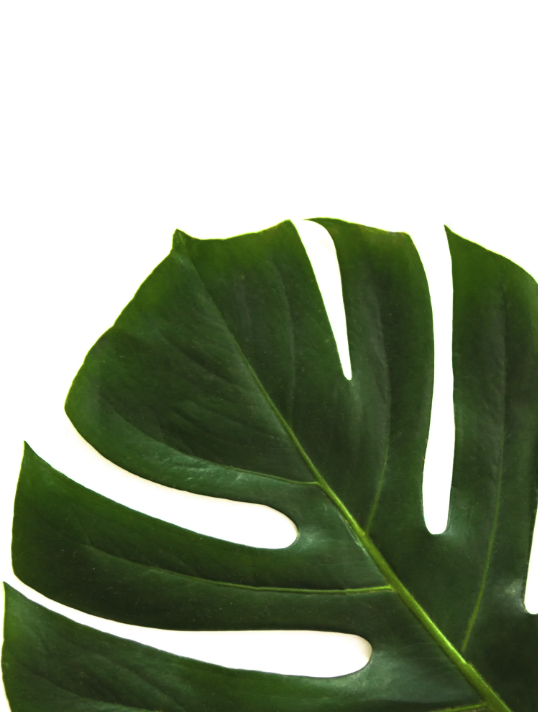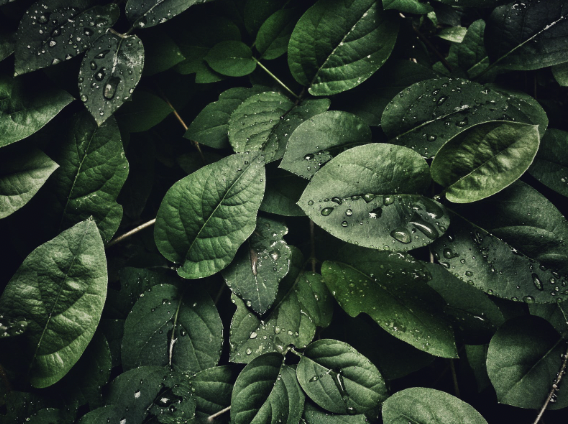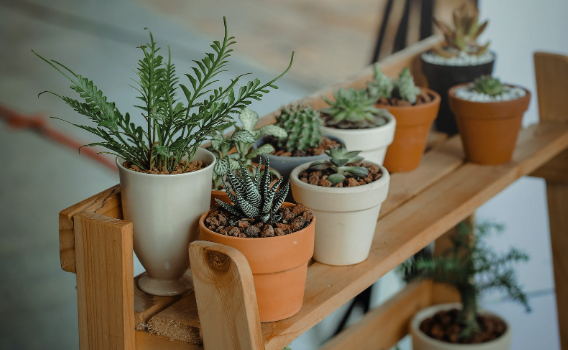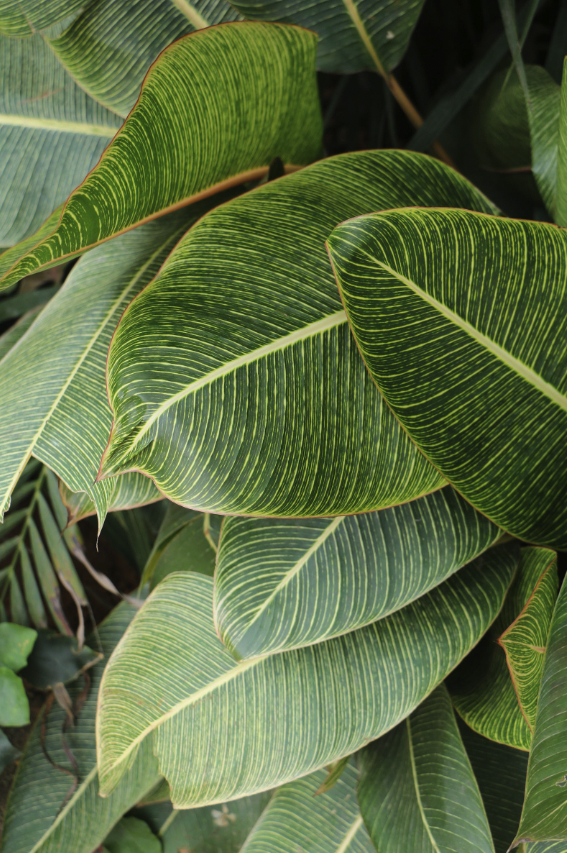Plant names, tree names, and botanical names are used to describe and distinguish plants.
Botanical names are Latin scientific names that refer to a particular species of plant or tree.
It is important to use the correct botanical name when making reference to a specific plant or tree, as different common names may be used for the same type of plant or tree in different places.
For example, the European beech (Fagus sylvatica) is also known as copper beech, purple beech, and blue beech depending on its color.
In this article, we look at plant names for plants and trees themselves, as well as for other things, such as those considering plant names for a pet or even a new baby.
Let’s take a look.
Plant Naming Conventions
When describing a species of plant or tree, botanists will use two words that represent its genus and species respectively.
The first word denotes its genus classification – usually the genus is capitalized; and the second word represents its species identification – this is usually not capitalized.
For example, Acer saccharum is the scientific name for sugar maple. Acer is the genus and saccharum refers to its species.
Doing research on plants or trees? Make sure to use their botanical names correctly! A correct identification of a plant or tree can help you learn more about it, as well as make sure your project or garden has the right specimens in it.
Tree Naming Conventions
Similar to plants and other organisms, trees are also divided into genera and species for identification purposes.
Again, the first word denotes its genus classification, usually capitalized (e.g., Pinus for pine) and the second word represents its species identification, usually not capitalized (e.g., sylvestris for Scotia Pine).
Knowing the correct tree names is important to ensure that you use the right specimen in a project or landscape.
Using an incorrect tree name could also lead to confusion and misunderstandings when consulting with experts or sharing your findings with colleagues.
With that said, let’s get into the lists.
Ornamental Plant Names
Here are a few ideas for names for ornamental plants:
- Aconitum (also known as monkshood or wolfsbane)
- Agapanthus (also known as African lily or lily of the Nile)
- Alstroemeria (also known as Peruvian lily or lily of the Incas)
- Anemone (also known as windflower)
- Armeria (also known as sea thrift or thrift)
- Astrantia (also known as masterwort or Hattie’s pincushion)
- Brunnera (also known as Siberian bugloss or heartleaf)
- Campanula (also known as bellflower)
- Echinacea (also known as coneflower)
- Eryngium (also known as sea holly)
- Fuchsia (also known as lady’s eardrops)
- Helleborus (also known as hellebore or Christmas rose)
- Heuchera (also known as coralbells or alumroot)
- Kniphofia (also known as red-hot poker or torch lily)
- Lamium (also known as deadnettle)
- Lavandula (also known as lavender)
- Leucanthemum (also known as Shasta daisy)
- Liatris (also known as gayfeather or blazing star)
- Lupinus (also known as lupine or wolfsbane)
- Monarda (also known as bee balm or horsemint)
- Papaver (also known as poppy)
- Penstemon (also known as beardtongue)
- Persicaria (also known as knotweed or smartweed)
- Phlox (also known as phlox or mountain-lover)
- Rudbeckia (also known as black-eyed Susan or gloriosa daisy)
- Salvia (also known as sage)
- Sedum (also known as stonecrop or liveforever)
- Stachys (also known as betony or lamb’s ears)
- Thalictrum (also known as meadow-rue or king-of-the-meadow)
- Verbascum (also known as mullein or candlewick plant)
- Zinnia (also known as zinnia)
These are just a few ideas to get you started.
There are many more types of ornamental plants, each with its own unique characteristics and common names.

Indoor Plant Names
Below are some names for indoor plants:
- Aglaonema (also known as Chinese evergreen)
- Alocasia (also known as elephant’s ear or African mask plant)
- Asparagus fern (also known as emerald feather or plumosa fern)
- Begonias (also known as wax begonias or fibrous begonias)
- Chlorophytum (also known as spider plant or airplane plant)
- Cissus (also known as grape ivy or oakleaf ivy)
- Coffea (also known as coffee plant)
- Cordyline (also known as Ti plant or Hawaiian good-luck plant)
- Croton (also known as Joseph’s coat or variegated croton)
- Dieffenbachia (also known as dumb cane)
- Epipremnum (also known as pothos or devil’s ivy)
- Ficus (also known as fig or weeping fig)
- Hedera (also known as ivy)
- Impatiens (also known as balsam or touch-me-not)
- Maranta (also known as prayer plant or herringbone plant)
- Monstera (also known as Swiss cheese plant or split-leaf philodendron)
- Nepenthes (also known as tropical pitcher plant or monkey cup)
- Oxalis (also known as shamrock or wood sorrel)
- Peperomia (also known as pepper face or radiator plant)
- Philodendron (also known as sweetheart plant or heartleaf philodendron)
- Pilea (also known as Chinese money plant or pancake plant)
- Sansevieria (also known as snake plant or mother-in-law’s tongue)
- Schefflera (also known as umbrella plant or octopus tree)
- Spathiphyllum (also known as peace lily or white sails)
- Syngonium (also known as arrowhead vine or goosefoot)
- Zamioculcas (also known as ZZ plant or aroid palm)
Succulents Plant Names
Succulents are plants that have thick, fleshy leaves or stems and are able to store water in their tissues, allowing them to survive in dry or arid environments.
Here are a few ideas for names for succulent plants:
- Adenium (also known as desert rose or impala lily)
- Aloe (also known as aloe vera or medicinal aloe)
- Aporocactus (also known as fishbone cactus or zigzag cactus)
- Astroloba (also known as spiral aloe or star-leaved aloe)
- Aeonium (also known as tree houseleek or Irish rose)
- Ceropegia (also known as string of hearts or chain of hearts)
- Crassula (also known as jade plant or money plant)
- Echeveria (also known as hen and chicks or Mexican snowball)
- Euphorbia (also known as spurge or poinsettia)
- Gasteria (also known as ox tongue or stomach plant)
- Graptopetalum (also known as ghost plant or mother-of-pearl plant)
- Hoya (also known as wax plant or porcelain flower)
- Kalanchoe (also known as flaming Katy or mother-of-thousands)
- Kalanchoe (also known as panda plant or chocolate soldier)
- Lithops (also known as living stones or pebble plants)
- Opuntia (also known as prickly pear or Indian fig)
- Pachyphytum (also known as moonstones or jelly beans)
- Portulacaria (also known as elephant’s food or small-leaved jade plant)
- Sedum (also known as stonecrop or liveforever)
- Sempervivum (also known as hen and chicks or houseleek)
- Senecio (also known as string of pearls or string of bananas)
- Echeveria (also known as Mexican snowball or hens and chicks)
- Haworthia (also known as window plant or zebra plant)
These are just a few examples of the many different types of succulent plants that are available.
Succulents come in a wide variety of shapes, sizes, and colors, and they are popular plants for both indoor and outdoor gardens.
They are known for their ability to tolerate dry conditions and are easy to care for, making them a popular choice for people with busy lifestyles.
PLANT NAMES 101 ~Learning about Latin/Taxonomic/Botanical naming~
Cute Plant Names
Below are a few ideas for cute names for plants:
- Buttercup
- Clover
- Daffodil
- Daisy
- Fern
- Honeysuckle
- Lavender
- Marigold
- Petunia
- Rose
- Sunflower
- Tulip
- Violet
These are just a few ideas to get you started.
You can also consider naming your plant after a favorite character from literature, film, or television, or you can choose a name that reflects the plant’s appearance or characteristics.
Whatever name you choose, make sure it is something that you like and that fits your plant well.

Funny Plant Names
Some ideas for funny names for plants:
- Aloe-vera-fication
- Cactus McPricklyface
- Fern Gully
- Flaming Katy Perry
- Herb-aceous
- Ivy League
- Marijuanilla
- Mr. Fernly
- Poison Ivy League
- Rosemary’s Baby
- Succulent Savage
- The Cactus Whisperer
- Willow the Wisp
You can also consider using a play on words or pun to create a humorous plant name.
Herbal Names
Here are a few ideas for names for herbs:
- Basil
- Chamomile
- Cilantro
- Dill
- Fennel
- Lavender
- Lemon balm
- Marjoram
- Oregano
- Parsley
- Rosemary
- Sage
- Thyme
These are a few of the many different types of herbs that are available.
Herbs are plants that are valued for their aromatic or medicinal properties, and they are commonly used in cooking, perfumes, and traditional medicine.
There are hundreds of different herbs that are used for a variety of purposes, and each herb has its own unique characteristics and uses.

Plant Names for Babies
A few ideas for names for babies inspired by plants:
- Alder
- Aspen
- Birch
- Clover
- Fern
- Hazel
- Holly
- Ivy
- Maple
- Olive
- Rowan
- Willow
You can also consider naming your baby after a favorite flower or herb, or you can choose a name that reflects the plant’s appearance or characteristics.
Plant Names and Meanings
Here is a list of a few plants and their meanings:
- Acacia: symbolizes resurrection
- Aloe vera: symbolizes immortality
- Bamboo: symbolizes endurance and strength
- Cherry blossom: symbolizes the transience of life
- Chrysanthemum: symbolizes fidelity, optimism, joy, and long life
- Daffodil: symbolizes unrequited love or regard
- Daisy: symbolizes innocence and purity
- Fern: symbolizes sincerity
- Lavender: symbolizes devotion and faithfulness
- Maple: symbolizes balance and promise
- Oak: symbolizes strength and endurance
- Orchid: symbolizes love, beauty, and refinement
- Rose: symbolizes love and appreciation
- Sunflower: symbolizes adoration and loyalty
- Tulip: symbolizes perfect love
- Willow: symbolizes mourning and sadness
Different types of plants and their common names
Plant Names for People
Here are a few plants that are often used as names for people:
- Aiden: a variant of the Irish name Aodhán, which means “fiery one.”
- Daisy: a feminine name that comes from the Old English word “dægesege,” meaning “day’s eye.”
- Fern: a unisex name that comes from the Old English word “fearn,” which refers to a type of fern.
- Ivy: a feminine name that comes from the Old English word “ifig,” which refers to the ivy plant.
- Jasper: a masculine name that comes from the Persian word “gaspar,” which means “treasurer.”
- Laurel: a unisex name that comes from the Latin word “laurus,” which refers to the laurel plant.
- Lily: a feminine name that comes from the Old English word “lilie,” which refers to the lily flower.
- Maple: a unisex name that comes from the Old English word “maple,” which refers to the maple tree.
- Oak: a masculine name that comes from the Old English word “ac,” which refers to the oak tree.
- Sage: a unisex name that comes from the Old English word “seage,” which means “wise.”
- Willow: a feminine name that comes from the Old English word “welig,” which refers to the willow tree.
Plant Names for Girls
Below are a few plants that are often used as names for girls:
- Amber: a feminine name that comes from the Arabic word “ambar,” which means “perfume.”
- Daisy: a feminine name that comes from the Old English word “dægesege,” meaning “day’s eye.”
- Ivy: a feminine name that comes from the Old English word “ifig,” which refers to the ivy plant.
- Lavender: a feminine name that comes from the Old French word “lavandre,” which means “to wash.”
- Lily: a feminine name that comes from the Old English word “lilie,” which refers to the lily flower.
- Marigold: a feminine name that comes from the Old English words “mere,” meaning “lake,” and “geld,” meaning “gold.”
- Petunia: a feminine name that comes from the Latin word “petun,” which means “tobacco.”
- Rose: a feminine name that comes from the Latin word “rosa,” which refers to the rose flower.
Plant Names for Boys
A few plants that are often used as names for boys:
- Aiden: a variant of the Irish name Aodhán, which means “fiery one.”
- Aspen: a masculine name that comes from the Old English word “æspe,” which refers to the aspen tree.
- Fern: a unisex name that comes from the Old English word “fearn,” which refers to a type of fern.
- Jasper: a masculine name that comes from the Persian word “gaspar,” which means “treasurer.”
- Laurel: a unisex name that comes from the Latin word “laurus,” which refers to the laurel plant.
- Maple: a unisex name that comes from the Old English word “maple,” which refers to the maple tree.
- Oak: a masculine name that comes from the Old English word “ac,” which refers to the oak tree.
- Sage: a unisex name that comes from the Old English word “seage,” which means “wise.”
Joke Plant Names
Here are a few jokes about plant names:
- Why did the tomato turn red? Because it saw the salad dressing!
- What did the cactus say to the other cactus? “You’re a real prickly pear.”
- Why was the plant feeling depressed? Because it was having a bad leaf day.
- Why was the plant feeling ambitious? Because it wanted to climb the corporate ladder.
- What did the Venus flytrap say to the fly? “You’re my prey-mate!”
I hope these jokes gave you a good laugh! (Ok… they were bad, we admit it…)
Plant Names for Dogs
A few plant-themed names that could be good for dogs:
- Aloe: a name inspired by the aloe vera plant, which is known for its healing properties.
- Clover: a name inspired by the clover plant, which is known for its four-leafed flowers.
- Fern: a name inspired by the fern plant, which is known for its delicate fronds.
- Ivy: a name inspired by the ivy plant, which is known for its climbing vines.
- Jasmine: a name inspired by the jasmine plant, which is known for its fragrant flowers.
- Laurel: a name inspired by the laurel plant, which is known for its shiny, evergreen leaves.
- Marigold: a name inspired by the marigold plant, which is known for its bright, sunny flowers.
- Sage: a name inspired by the sage plant, which is known for its fragrant, silvery-gray leaves.
- Willow: a name inspired by the willow tree, which is known for its graceful, drooping branches.
Plant Names with the Word ‘Green’ in Them
Here are a few plants with green in their names:
- Greenbrier: a plant with green, thorny stems and small, white flowers.
- Greengage: a type of plum with green skin and sweet, yellow flesh.
- Greenhood: a type of orchid with green flowers.
- Greenshield: a type of lichen with a green, shield-shaped growth.
- Greenstem: a type of fern with green stems and delicate fronds.
- Greenway: a type of grass with green, slender blades.
- Greenweed: a type of flowering plant with green leaves and small, white flowers
Scientific Plant Names
In scientific classification, plants are given a two-part scientific name.
The first part is the genus name, and the second part is the species name.
For example, the scientific name for the rose is Rosa.
The scientific name is used to uniquely identify a plant species, and it is typically written in italics.
Here are a few more examples of scientific plant names:
- Acer: a genus of trees and shrubs, including the maple.
- Citrus: a genus of trees and shrubs, including the orange, lemon, and lime.
- Ficus: a genus of trees and shrubs, including the fig.
- Helianthus: a genus of plants, including the sunflower.
- Nicotiana: a genus of plants, including tobacco.
- Solanum: a genus of plants, including the tomato and potato.
- Zea: a genus of plants, including corn.
Plant Names List
A good list of plants and their scientific names:
- Aloe vera: Aloe vera
- Bamboo: Bambusa
- Cherry blossom: Prunus
- Chrysanthemum: Chrysanthemum
- Daffodil: Narcissus
- Daisy: Bellis
- Fern: Polypodiopsida
- Lavender: Lavandula
- Maple: Acer
- Oak: Quercus
- Orchid: Orchidaceae
- Rose: Rosa
- Sunflower: Helianthus
- Tulip: Tulipa
- Willow: Salix
Cool Plant Names
Here are a few plants with unique or interesting names:
- Airplant: a type of plant that grows without soil and gets its nutrients from the air.
- Creeping Charlie: a type of plant with purple flowers and small, round leaves that grows low to the ground.
- Devil’s Ivy: a type of vine with shiny, heart-shaped leaves and small, yellow flowers.
- Dragon Tree: a type of tree with thin, spiky leaves and red sap.
- Elephant Ear: a type of plant with large, heart-shaped leaves that resemble elephant ears.
- Ghost Plant: a type of plant with white or silvery foliage.
- Jelly Bean Plant: a type of plant with small, bean-shaped leaves that grow in clusters.
- King Tut: a type of grass with long, thin blades that are yellow at the base and green at the tip.
- Living Stone: a type of plant with small, round leaves that resemble stones.
- String of Pearls: a type of plant with small, round leaves that resemble pearls.
I hope this list gives you some ideas for unique plant names!
Pretty Plant Names
A few plants with pretty names:
- Bluebell: a type of plant with delicate, bell-shaped flowers that are typically blue or purple.
- Butterfly Bush: a type of shrub with fragrant flowers that attract butterflies.
- Camellia: a type of shrub with large, showy flowers that come in a variety of colors.
- Foxglove: a type of plant with tall, spiky flowers that are typically purple or pink.
- Honeysuckle: a type of vine with fragrant flowers that come in a variety of colors.
- Jasmine: a type of vine with fragrant, star-shaped flowers that are typically white or yellow.
- Lavender: a type of shrub with fragrant, purple flowers.
- Morning Glory: a type of vine with large, trumpet-shaped flowers that are typically blue or purple.
- Peony: a type of shrub with large, showy flowers that come in a variety of colors.
- Rose: a type of shrub with fragrant, showy flowers that come in a variety of colors.
- Tulip: a type of plant with large, cup-shaped flowers that come in a variety of colors.
House Plant Names
Here are a few common house plants and their scientific names:
- African violet: Saintpaulia
- Aloe vera: Aloe vera
- Chinese evergreen: Aglaonema
- Peace lily: Spathiphyllum
- Philodendron: Philodendron
- Pothos: Epipremnum aureum
- Snake plant: Sansevieria
- Spider plant: Chlorophytum
- ZZ plant: Zamioculcas zamiifolia
Unique Plant Names
A few plants with unique or unusual names:
- Black Bat Flower: a type of plant with black, bat-shaped flowers and large, dark leaves.
- Brain Cactus: a type of cactus with brain-like bumps on its surface.
- Dancing Girls: a type of plant with small, pink flowers that resemble dancing figures.
- Devil’s Claw: a type of plant with long, claw-like fruits.
- Dragon’s Blood Tree: a type of tree with red sap that is used as a dye.
- Flying Saucer Plant: a type of plant with round, saucer-shaped leaves that are green on top and purple on the bottom.
- Heart’s Delight: a type of plant with small, heart-shaped leaves and pink flowers.
- Mother-in-Law’s Tongue: a type of plant with long, sword-shaped leaves.
- Old Man Cactus: a type of cactus with long, white hairs that resemble an old man’s beard.
- Starfish Plant: a type of plant with star-shaped flowers that come in a variety of colors.
Latin Plant Names
Latin is a classical language that was spoken in ancient Rome and is still used today in scientific and other academic fields.
Many plant names are derived from Latin and can be helpful in understanding the characteristics or properties of a particular plant.
For example, the Latin name “Quercus” refers to oak trees, and the Latin name “Salvia” refers to sage.
Here are some common Latin plant names and their meanings:
- Acer: maple
- Aesculus: horse chestnut
- Alchemilla: lady’s mantle
- Allium: onion
- Anemone: windflower
- Aquilegia: columbine
- Arbutus: strawberry tree
- Betula: birch
- Brassica: mustard, cabbage
- Calendula: marigold
- Campanula: bellflower
- Cannabis: hemp
- Capsella: shepherd’s purse
- Carthamus: safflower
- Cedrus: cedar
- Cercis: redbud
- Chrysanthemum: chrysanthemum
- Cichorium: chicory
- Cimicifuga: bugbane
- Clematis: clematis
- Convallaria: lily of the valley
- Coreopsis: tickseed
- Cornus: dogwood
- Crocus: crocus
- Digitalis: foxglove
- Echinacea: coneflower
- Eryngium: eryngo, sea holly
- Eucalyptus: eucalyptus
- Fagus: beech
- Fritillaria: fritillary
- Galium: bedstraw
- Ginkgo: ginkgo
- Heuchera: coralbells
- Hosta: plantain lily
- Hydrangea: hydrangea
- Hypericum: St. John’s wort
- Iris: iris
- Lavandula: lavender
- Liriodendron: tulip tree
- Lonicera: honeysuckle
- Lupinus: lupine
- Magnolia: magnolia
- Narcissus: daffodil
- Papaver: poppy
- Penstemon: beardtongue
- Persicaria: fleeceflower
- Picea: spruce
- Pinus: pine
- Platanus: plane tree
- Polygonatum: Solomon’s seal
- Prunus: plum, cherry, almond
- Pulsatilla: pasque flower
- Quercus: oak
- Ranunculus: buttercup
- Rhododendron: rhododendron
- Rosa: rose
- Salvia: sage
- Sanguisorba: burnet
- Saponaria: soapwort
- Saxifraga: saxifrage
- Sedum: stonecrop
- Solidago: goldenrod
- Syringa: lilac
- Tanacetum: tansy
- Taxus: yew
- Thymus: thyme
- Trillium: trillium
- Tulipa: tulip
- Vaccinium: blueberry
- Verbena: vervain
- Vinca: periwinkle
- Vitis: grape
- Zinnia: zinnia
Weird Plant Names
There are many plants with interesting, weird, unique, or unusual names.
Below are a few examples:
- Aconitum: also known as “monkshood” or “wolfsbane”
- Actaea: also known as “bugbane” or “black cohosh”
- Agave: also known as “century plant” or “maguey”
- Alcea: also known as “hollyhock”
- Alchemilla: also known as “lady’s mantle”
- Allium: also known as “ornamental onion”
- Amaranthus: also known as “tumbleweed” or “pigweed”
- Arum: also known as “lords-and-ladies” or “cuckoo pint”
- Asarum: also known as “wild ginger”
- Astilbe: also known as “false spirea”
- Brugmansia: also known as “angel’s trumpet”
- Caltha: also known as “marsh marigold”
- Cerastium: also known as “mouse-ear chickweed”
- Chenopodium: also known as “goosefoot”
- Colchicum: also known as “autumn crocus”
- Consolida: also known as “larkspur”
- Convallaria: also known as “lily of the valley”
- Digitalis: also known as “foxglove”
- Eryngium: also known as “sea holly”
- Euonymus: also known as “spindle tree”
- Fuchsia: also known as “fuchsia”
- Galanthus: also known as “snowdrop”
- Hedera: also known as “ivy”
- Helleborus: also known as “hellebore” or “Christmas rose”
- Heuchera: also known as “coralbells”
- Hosta: also known as “plantain lily”
- Hyacinthoides: also known as “bluebell”
- Hyacinthus: also known as “hyacinth”
- Hypericum: also known as “St. John’s wort”
- Ilex: also known as “holly”
- Impatiens: also known as “touch-me-not” or “balsam”
- Kniphofia: also known as “red-hot poker”
- Ligularia: also known as “leopard plant”
- Liriodendron: also known as “tulip tree”
- Lunaria: also known as “honesty” or “moonwort”
- Lychnis: also known as “campion”
- Lysichiton: also known as “skunk cabbage”
- Magnolia: also known as “magnolia”
- Narcissus: also known as “daffodil” or “narcissus”
- Nepeta: also known as “catmint”
- Oenothera: also known as “evening primrose”
- Osmunda: also known as “royal fern”
- Papaver: also known as “poppy”
- Paeonia: also known as “peony”
- Passiflora: also known as “passionflower”
- Penstemon: also known as “beardtongue”
- Persicaria: also known as “fleeceflower”
- Petasites: also known as “butterbur”
- Petunia: also known as “petunia”
- Phlox: also known as “phlox”
- Platycodon: also known as “balloon flower”
- Polygonatum: also known as “Solomon’s seal”
- Primula: also known as “primrose”
- Pulsatilla: also known as “pasque flower”
- Ranunculus: also known as “buttercup”
- Rheum: also known as “rhubarb”
- Rosa: also known as “rose”
- Salix: also known as “willow”
- Sambucus: also known as “elderberry”
- Sanguisorba: also known as “burnet”
- Saponaria: also known as “soapwort”
- Saxifraga: also known as “saxifrage”
- Sedum: also known as “stonecrop”
- Sempervivum: also known as “hen-and-chicks”
- Solidago: also known as “goldenrod”
- Sparganium: also known as “bur-reed”
- Stachys: also known as “lamb’s ear”
- Syringa: also known as “lilac”
- Tanacetum: also known as “tansy”
- Taxus: also known as “yew”
- Thymus: also known as “thyme”
- Trifolium: also known as “clover”
- Trillium: also known as “trillium”
- Trollius: also known as “globe flower”
- Tulipa: also known as “tulip”
- Vaccinium: also known as “blueberry”
- Verbena: also known as “vervain”
- Viburnum: also known as “viburnum”
- Vinca: also known as “periwinkle”
- Viola: also known as “violet”
- Vitis: also known as “grape”
- Xanthorhiza: also known as “yellowroot”
- Zinnia: also known as “zinnia”
Plant Names in English
Here is a list of common plant names in English:
- Aloe vera: also known as “aloe”
- Apple: also known as “apple”
- Basil: also known as “basil”
- Cherry: also known as “cherry”
- Chili pepper: also known as “chili pepper” or “chilli pepper”
- Cilantro: also known as “coriander”
- Cucumber: also known as “cucumber”
- Eggplant: also known as “aubergine
- Fennel: also known as “fennel”
- Lavender: also known as “lavender”
- Lemon: also known as “lemon”
- Mint: also known as “mint”
- Olive: also known as “olive”
- Onion: also known as “onion”
- Oregano: also known as “oregano”
- Parsley: also known as “parsley”
- Pea: also known as “pea”
- Peach: also known as “peach”
- Pear: also known as “pear”
- Pepper: also known as “pepper” (not to be confused with chili pepper)
- Plum: also known as “plum”
- Potato: also known as “potato”
- Raspberry: also known as “raspberry
- Rosemary: also known as “rosemary”
- Sage: also known as “sage”
- Spinach: also known as “spinach”
- Strawberry: also known as “strawberry”
- Tomato: also known as “tomato”
- Zucchini: also known as “courgette
FAQs – Plant Names
What are good names for a plant?
There are many factors to consider when choosing a name for a plant.
Some things to consider might include the appearance or characteristics of the plant, the location where it is grown, or the cultural or historical significance of the plant.
Here are a few ideas for plant names:
- Aurora: meaning “dawn” in Latin, this could be a good name for a plant with vibrant flowers that bloom in the morning
- Celestia: meaning “heavenly” in Latin, this could be a good name for a plant with delicate or ethereal flowers
- Fern: this could be a good name for a plant with fern-like leaves
- Iris: named after the Greek goddess of the rainbow, this could be a good name for a plant with colorful flowers
- Jade: this could be a good name for a plant with glossy, jade-green leaves
- Luna: meaning “moon” in Latin, this could be a good name for a plant with pale or silvery foliage
- Marigold: this could be a good name for a plant with bright, sunny flowers
- Misty: this could be a good name for a plant with soft, misty-looking flowers or foliage
- Willow: this could be a good name for a plant with slender, willowy stems or branches.
What are common plant names?
Here is a list of some common plant names:
- Aloe vera: also known as “aloe”
- Apple: also known as “apple”
- Basil: also known as “basil”
- Cherry: also known as “cherry”
- Chili pepper: also known as “chili pepper” or “chilli pepper”
- Cilantro: also known as “coriander”
- Cucumber: also known as “cucumber”
- Eggplant: also known as “aubergine”
- Fennel: also known as “fennel”
- Lavender: also known as “lavender”
- Lemon: also known as “lemon”
- Mint: also known as “mint”
- Olive: also known as “olive”
- Onion: also known as “onion”
- Oregano: also known as “oregano”
- Parsley: also known as “parsley”
- Pea: also known as “pea”
- Peach: also known as “peach”
- Pear: also known as “pear”
- Pepper: also known as “pepper” (not to be confused with chili pepper)
- Plum: also known as “plum”
- Potato: also known as “potato”
- Raspberry: also known as “raspberry”
- Rosemary: also known as “rosemary”
- Sage: also known as “sage”
- Spinach: also known as “spinach”
- Strawberry: also known as “strawberry”
- Tomato: also known as “tomato”
- Zucchini: also known as “courgette”
What is a list of plants?
Here is a list of 100 plants:
- Aloe vera
- Basil
- Cactus
- Lavender
- Lemon balm
- Orchid
- Rose
- Spider plant
- Succulent
- Sunflower
- African violet
- Apple tree
- Asparagus
- Avocado tree
- Bamboo
- Begonia
- Blackberry bush
- Blueberry bush
- Cabbage
- Cactus
- Calla lily
- Carrot
- Cherry tree
- Chrysanthemum
- Cilantro
- Collard greens
- Corn
- Daffodil
- Daisy
- Dandelion
- Eggplant
- Elderberry bush
- Fennel
- Fern
- Fig tree
- Gardenia
- Geranium
- Gladiolus
- Grapefruit tree
- Grapes
- Green bean
- Green pepper
- Hibiscus
- Hosta
- Hydrangea
- Jade plant
- Kiwi fruit
- Kale
- Lavender
- Leek
- Lemongrass
- Lemon tree
- Lettuce
- Lime tree
- Marigold
- Melon
- Mint
- Nasturtium
- Onion
- Orange tree
- Oregano
- Papaya tree
- Parsley
- Passionfruit
- Pea
- Peach tree
- Pear tree
- Peas
- Peppers
- Petunia
- Pineapple
- Pine tree
- Plum tree
- Potato
- Pumpkin
- Radish
- Raspberry bush
- Red onion
- Rhubarb
- Rose
- Rosemary
- Sage
- Spinach
- Strawberry
- Sweet potato
- Swiss chard
- Thyme
- Tomato
- Tulip
- Turnip
- Watermelon
- Wheatgrass
- Wildflower
- Willow tree
- Yarrow
- Yellow squash
- Zucchini
- Aroid
- Cattail
- Grassy plants
This is just a small sampling of the many different types of plants that exist.
There are thousands of different species of plants, ranging from small herbs to towering trees.
Some plants are grown for their beauty, while others are grown for their medicinal or culinary uses.
What is a cool tree name?
Below are a few ideas for cool tree names:
- Willow
- Redwood
- Oak
- Maple
- Birch
- Cypress
- Elm
- Pine
- Spruce
- Palm
- Mahogany
- Cherry
- Apple
- Lemon
- Orange
- Grapefruit
- Olive
- Plum
- Peach
- Apricot
- Fig
- Pecan
- Walnut
- Hazelnut
- Chestnut
You could also consider using a unique or unusual word as a tree name, or using a name that reflects the tree’s characteristics or appearance.
For example, a tall, slender tree might be called “Skyward” or a tree with bright, colorful leaves might be called “Fiesta.”
What is a rare flower name?
There are many rare and exotic flowers that have unusual or unique names.
Here are a few examples:
- Aconitum (also known as monkshood or wolfsbane)
- Adenium (also known as desert rose)
- Aechmea (a type of bromeliad)
- Agave (a type of succulent)
- Allium (a type of onion)
- Alstroemeria (also known as the Peruvian lily)
- Amorphophallus (a type of flowering plant)
- Anemone (also known as windflower)
- Anthurium (a type of tropical flowering plant)
- Arisaema (a type of flowering plant)
- Aristolochia (a type of flowering plant)
- Arum (a type of flowering plant)
- Asclepias (a type of milkweed)
- Astilbe (a type of flowering plant)
- Brugmansia (also known as angel’s trumpet)
- Calathea (a type of tropical flowering plant)
- Calypso (a type of orchid)
- Campanula (also known as bellflower)
- Canna (a type of flowering plant)
- Celosia (a type of flowering plant)
- Ceropegia (a type of flowering plant)
- Cimicifuga (also known as bugbane)
- Clematis (a type of flowering vine)
- Colchicum (also known as meadow saffron)
- Cymbidium (a type of orchid)
- Dendrobium (a type of orchid)
- Disa (a type of orchid)
- Echeveria (a type of succulent)
- Epiphyllum (also known as orchid cactus)
- Eranthis (also known as winter aconite)
- Erythronium (also known as dog’s-tooth violet)
- Fritillaria (a type of flowering plant)
- Galanthus (also known as snowdrop)
- Habenaria (a type of orchid)
- Hedychium (also known as ginger lily)
- Helleborus (also known as hellebore)
- Hoya (a type of flowering plant)
- Impatiens (also known as balsam)
- Iris (a type of flowering plant)
- Isopyrum (also known as false rue anemone)
- Kniphofia (also known as red hot poker)
- Laelia (a type of orchid)
- Lathyrus (a type of flowering plant)
- Ledebouria (a type of flowering plant)
- Lepanthes (a type of orchid)
- Liparis (a type of orchid)
- Lobelia (a type of flowering plant)
- Lycaste (a type of orchid)
- Lysichiton (also known as skunk cabbage)
- Magnolia (a type of flowering tree)
- Malaxis (a type of orchid)
- Masdevallia (a type of orchid)
- Meconopsis (also known as poppy)
- Meliosma (a type of flowering plant)
- Mokara (a type of orchid)
- Montipora (a type of coral)
- Musa (also known as banana)
- Neofinetia (a type of orchid)
- Nothoscordum (a type of flowering plant)
- Oenothera (also known as evening primrose)
- Oncidium (a type of orchid)
- Oreochromis (also known as tilapia)
- Oxalis (also known as wood sorrel)
- Paeonia (also known as peony)
- Paphiopedilum (a type of orchid)
- Passiflora (also known as passionflower)
- Penstemon (a type of flowering plant)
- Phaius (a type of orchid)
- Philodendron (a type of tropical flowering plant)
- Phlox (a type of flowering plant)
- Phragmipedium (a type of orchid)
- Phygelius (a type of flowering plant)
- Plectranthus (a type of flowering plant)
- Pleione (a type of orchid)
- Podophyllum (also known as mayapple)
- Polypodium (a type of fern)
- Protea (a type of flowering plant)
- Pseudocydonia (also known as Chinese quince)
- Pterostylis (a type of orchid)
- Pyrostegia (also known as flame vine)
- Quercus (a type of oak tree)
- Ratibida (a type of flowering plant)
- Rhododendron (a type of flowering shrub)
- Roscoea (a type of flowering plant)
- Sarracenia (also known as pitcher plant)
- Sauromatum (also known as voodoo lily)
- Saxifraga (a type of flowering plant)
- Sedum (a type of succulent)
- Selenicereus (also known as night blooming cereus)
- Sempervivum (a type of succulent)
- Silene (a type of flowering plant)
- Sinningia (a type of flowering plant)
- Spathiphyllum (also known as peace lily)
- Stapelia (a type of flowering plant)
- Stenocactus (a type of cactus)
- Streptocarpus (a type of flowering plant)
- Syringa (also known as lilac)
- Talinum (a type of flowering plant)
- Tigridia (a type of flowering plant)
- Tricyrtis (a type of flowering plant)
- Trillium (a type of flowering plant)
- Trochodendron (also known as wheel tree)
- Ulex (a type of flowering plant)
- Uvularia (a type of flowering plant)
- Vaccinium (a type of flowering plant)
- Vernonia (a type of flowering plant)
- Viburnum (a type of flowering plant)
- Viola (a type of flowering plant)
- Vitis (a type of grape vine)
- Wisteria (a type of flowering vine)
- Zantedeschia (also known as calla lily)
- Zephyranthes (also known as rain lily)
What is a rare plant name?
There are many rare plant species with unique and unusual names, some examples include:
- Ghost Orchid (Dendrophylax lindenii)
- Queen of the Andes (Puya raimondii)
- Corpse Flower (Amorphophallus titanum)
- Jade Vine (Strongylodon macrobotrys)
- Black Bat Flower (Tacca chantrieri)
- Venus Flytrap (Dionaea muscipula)
These are just a few examples, but there are many more rare and unusual plant species out there with interesting names.
What is the most unique plant?
It is difficult to say which plant is the most unique, as there are so many different plant species with unique characteristics.
Some plants have unique physical features, such as the Venus flytrap, which is known for its ability to trap insects with its hinged leaves.
Other plants have unique reproductive or survival strategies, such as the Wolffia, which is the smallest known flowering plant and reproduces vegetatively.
Still, other plants have cultural or historical significance, such as the lotus, which is a symbol of enlightenment in many Eastern cultures.
So, it is tough to pinpoint a single plant that could be considered the most unique.
Conclusion – Plant Names
Botanical names are an essential tool for accurately identifying plants and trees.
Knowing the proper plant and tree names can save time and energy when doing research, whether it’s for a project or just out of personal interest.
Always make sure to use the botanical name correctly – it will help both you, as well as those who read what you have written.
We hope that this article has given you some ideas to get started with your plant name search – and we’d love to hear what names you come up with! Good luck and happy naming!
Related
- Types of Mint Plants
- Types of Yucca Plants
- Types of Succulents
- Types of Aloe
- Types of Indoor Plants
- Types of Blue Flowers
- Types of Mint Plants
- Types of Elephant Ear Plants
- Types of Palm Plants
- Types of Acorns
- Fungi & Mushroom Names
- Green Fruit Types







